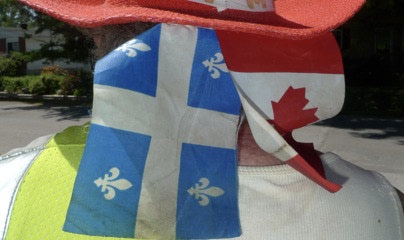John Egan: Pillar of the Community
Michelle Mondoux
John Egan was born in Lissavahaun, County Galway, Ireland on November 11, 1811, in the wake of the widespread uprising of 1798. Many residents of Galway had emigrated in Lower Canada and John Egan heard the call of the lumber industry in North America.
Shortly after he arrived in the area in 1830, he was hired as a depot clerk for Thomas Durrell in Clarendon Township. His job consisted of purchasing supplies for the growing number of lumber camps and hand ling administrative duties.
He had a plan – to adapt to North American customs, to learn as much as he could and to become the wealthiest man in the region.
With his horse and box-sleigh caparisoned in the French-Canadian manner, he wore a grey capot, a sash, a toque, moccasins and mitts.
Charming and elegant with exceptional oratorical qualities, he expressed himself in a most powerful tone of voice. He soon became a familiar figure in the surroundings as he made his way through the settlement, buying hay, oats, pork and other commodities needed for the shanties.
Having acquired experience and developed a network of friends and colleagues, he saw the advantages of settling in Aylmer. He opened a general store on Principale Street to supply lumber merchants and loggers. He also started in the trade himself.
Along with Charles Symmes, Robert Conroy and Harvey Parker, they financed Aylmer’s first grist mill and sawmill in 1839.
A devout Anglican, he gave generously to the establishment of Christ Church in Aylmer.
Egan was no crude lumber man on the rise. He protected his friends and if you said anything to jeopardize the reputation of his friends, he took the means to correct the situation. Such was the case with Andrew Powell, a Bytown lawyer. Powell had stated publicly that One of Egan’s intimate friends was no gentlemen. In the summer of 1838, to settle the matter, he invited Powell to settle the case by duel.
Shots were fired, they both missed and Powell withdrew his remarks.
Family Man
Nine years after arriving in Lower Canada, then 28 years of age, it was time to settle down and raise a family. Reverend John Cruickshank blessed the union as he exchanged marital vows with Anne Margaret Briscoe Gibson of Bytown on August 13, 1839.
Born in Tipperary, she was the eldest daughter of Captain William Gibson.
John and Ann Margaret had ten children, two of whom died in infancy. Their first son, William James was born on August 16, 1841 followed by Louisa, John LeMesurier, Frances Anne Matilda, William Francis, Henry Kelly, Amelia, Sarah, Aurelia and Adele Josephine.
Referred to throughout his life as genial and generous, the Montreal Gazette at one time referred to John Egan and Joseph Aumond as two of the finest looking men in Canada.
In 1846 he was appointed Major in the Battalion of Ottawa Militia commanded by Ruggles Wright. He served as Lieutenant-Colonel of the 4th Battalion. He was also a committee member of the Bytown Emigration Society presided by Thomas McKay.
In 1840, he had a large, elegant stone mansion built on Principale Street at the east entrance to Aylmer. Named Mount Pleasant, the house with its large windows and inserts of bird’s eye crystal, its oak panelled rooms and ballroom, was among the most prestigious in the area.
Visiting Governors-General and other dignitaries were entertained there at lavish banquets and balls. Mr. and Mrs. Charles Symmes, Robert Conroy, Harvey Parker, Joseph Aumond, Dr Peter Church, Judge McCord, Charles Devlin, Thomas Bingham Prentiss, Alexandre Bourgeau, William McLean, Ruggles Wright, George Bolton, Robert Klock, Henry Friel, Franklin Bronson, Nicholas Sparks and others received an invitation.
Built on thirty acres of land purchased from John Wright in 1840, the georgian style mansion has a balanced facade, 21/2 storey grey stone with quoining of dressed stone, a pitched roof and side gables. Special features include large front windows with multi-pane tops, a double front door with a flat transom and side lights, matched by an inner vestibule door of equal style.






